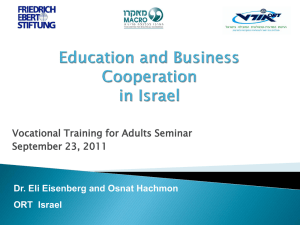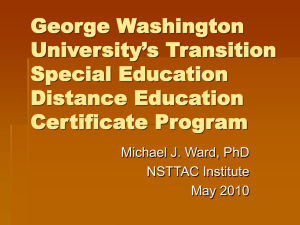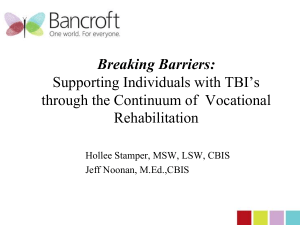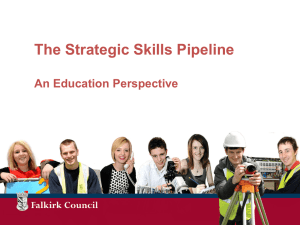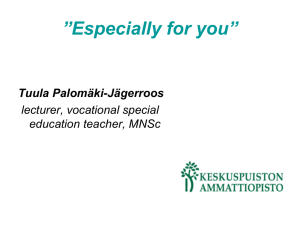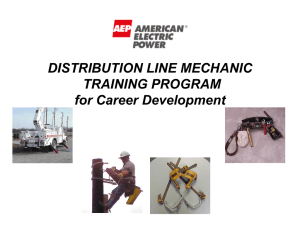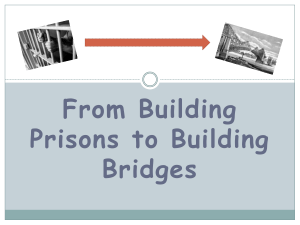Jeremy Higham`s presentation
advertisement
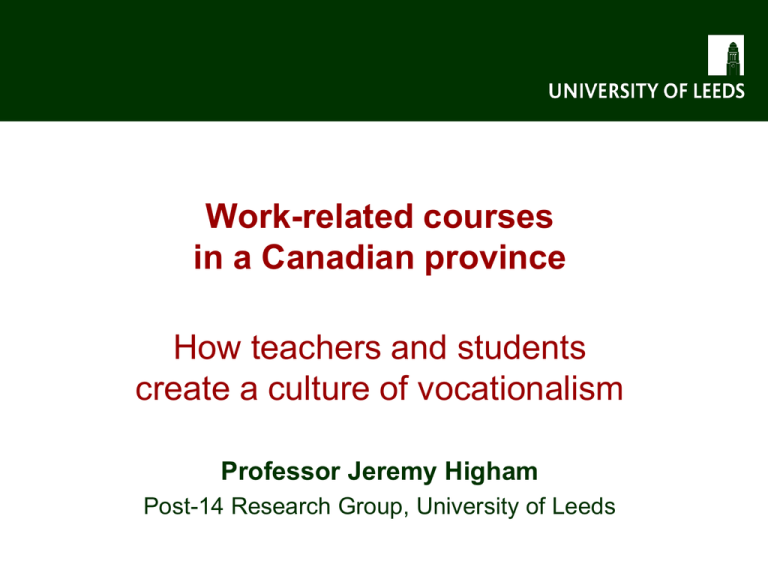
Work-related courses in a Canadian province How teachers and students create a culture of vocationalism Professor Jeremy Higham Post-14 Research Group, University of Leeds VOCATIONAL FRAMEWORK Institutional Context Purpose and aims of programmes Student recruitment Resources Staffing Curriculum Pedagogy Assessment CONTEXT Canadian High Schools Work-related courses for 15-18 year olds Board with long-standing vocational provision Multi-credit programmes combining Vocational diploma - Young Apprenticeship - WE Collaborative, teacher-led programmes CASE STUDY COURSES Promoted as work-related Innovative curriculum practice Range of occupational sectors Range of programme types and contexts Qualitative case study approach with a focus on the learner experience MILLWRIGHTING 'apprenticeship preparation for millwrights, machinists and welders' First semester in school technology workshop optional linked work-placement in the second semester. MILLWRIGHTING 'apprenticeship preparation for millwrights, machinists and welders' First semester in school technology workshop optional linked work-placement in the second semester. MOTOR VEHICLE MAINTENANCE 'towards future employment in the automotive transportation industry' 4 four-week blocks. 1st & 3rd blocks: school-based in a car maintenance workshop 2nd & 4th blocks: on work placement in a garage or dealership. HOUSE RENOVATION 'to assist students in gaining the skills necessary to become productive members of the construction industry'. Students worked on a series of renovation projects on houses. HOUSE RENOVATION 'to assist students in gaining the skills necessary to become productive members of the construction industry'. Students worked on a series of renovation projects on houses. HOUSE BUILDING 'prepares students for careers in carpentry, construction management, roofing, plumbing and electrical' Students built new houses for major building firms. HOUSE RENOVATION 'to assist students in gaining the skills necessary to become productive members of the construction industry'. Students worked on a series of renovation projects on houses. HOUSE BUILDING 'prepares students for careers in carpentry, construction management, roofing, plumbing and electrical' Students built new houses for major building firms. RADIO JOURNALISM 'to learn about journalism, sound production and music' gaining 'the hands-on experience you need to study radio or journalism after high school' and subsequently 'pursue an exciting career in broadcasting' Students ran a community radio station within the school. TEACHING AND LEARNING Task-led, problem-based with authentic projects, via Work Experience or real-world tasks Focus on making, building and servicing, vocational theory deconstructed later Individualised learning, master/apprentice model Modelling of vocational practices, strong emphasis on health and safety Mainly practical, outcome-based assessment Assessment against informal vocational criteria and formal curriculum expectations TEACHERS Typically strong vocational background with wealth of experience and expertise: • up-to-date understanding of industry practices and employer expectations • modelled vocational practice and induction into culture • industry contacts and networks: employer support for resources, placements, jobs • high levels of credibility with students. STUDENTS Student dispositions and identities: • self-selection and course recruitment: usually a positive orientation to occupational or vocational area • prior knowledge and involvement in the sector, through part-time or summer work or through family connections • involvement of former course members as veterans supported the vocational culture. HOUSE BUILDING Student dispositions and identities: - positive orientation to construction - prior involvement in the sector Tutor: vocational background: - expertise, experience, contacts - high levels of credibility and respect Students worked alongside industry professionals in the work place Vocational discourse and modelling Induction to the 'community of practice' within the industry Context-driven tasks with real-world consequences Master/apprentice model Outcome-based assessment against informal vocational criteria Learning as becoming HOUSE BUILDING Student dispositions and identities: - positive orientation to construction - prior involvement in the sector Tutor: vocational background: - expertise, experience, contacts - high levels of credibility and respect Students worked alongside industry professionals in the work place Vocational discourse and modelling Induction to the 'community of practice' within the industry Context-driven tasks with real-world consequences Master/apprentice model Outcome-based assessment against informal vocational criteria Learning as becoming RADIO JOURNALISM Student dispositions and identities: - positive orientation to music - no prior involvement in the sector Tutor: English teaching background: - editing skills - expert teacher Simulated work place Absence of reference to industry No induction to the vocational culture of the industry Authentic tasks Individualised learning Practical assessment against formal learning outcomes Learning as engagement SUMMARY Teacher background and contacts are central to vocational conception and experience of the course Students dispositions and identities, in particular their learning and career aspirations, influence the vocational nature of the course 'the process of curriculum making hinges as much upon the values and views of knowledge, learning, teaching, human nature and educational purposes which teachers bring to bear upon their work' Martin Bloomer (Curriculum Making in Post-16 Education: the social conditions of studentship. London: Routledge, 1997)

